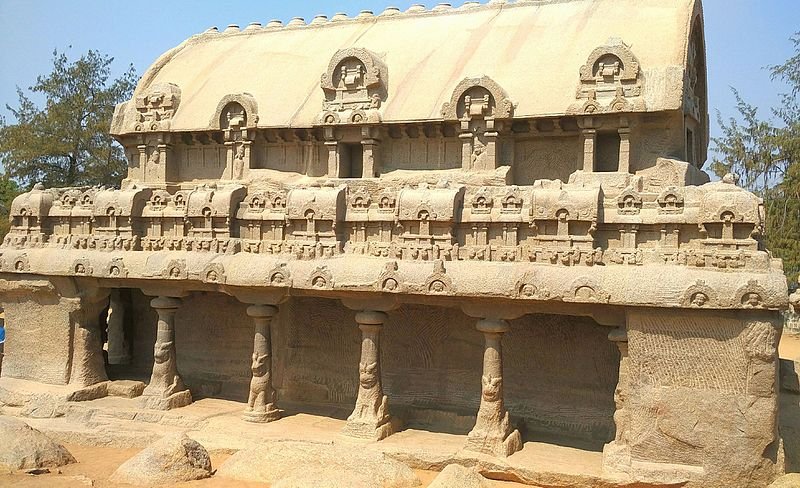Mahabalipuram: Ancient Ruined City And Its Marvellous Rock-Cut Architecture In South India
Angela Sutherland - AncientPages.com - Mahabalipuram is a ruined city located on the coast just 60 km south of Chennai. Even looking at the city’s ruins, it is obvious the place represents one of the most famous examples of ancient Indian art and architecture.
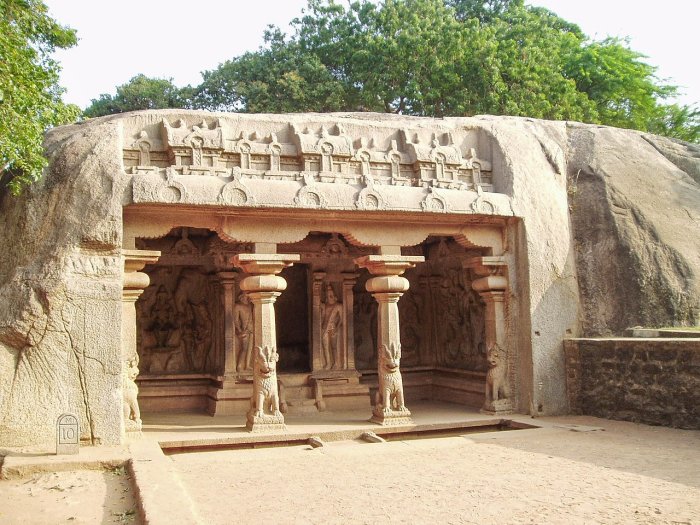 Varaha cave temple entrance. Image credit: Vsundar - CC BY-SA 3.0
Varaha cave temple entrance. Image credit: Vsundar - CC BY-SA 3.0
This Pallava old site has some of the earliest examples of architecture in South India, rock-cut cave temples, stone carvings, and the shore temple on the beach.
During the 7th to 10th centuries, it was a flourishing seaport (one of two) of the Pallava Dynasty of rulers, situated in the southeastern Indian state of Tamil Nadu.
In Mahabalipuram (also known as Mamallapuram), especially the Hindu Group of Monuments are famous landmarks because they represent the impressive architectural legacy of the Pallava rulers, and they are artistic and technical wonders. The city was prosperous economically and had a complex of royal monuments, of which several were carved out of living rock.
Mahabalipuram represents not only Dravidian architectural style. The Chola architecture highly influences this style and techniques used by other dynasties that followed.
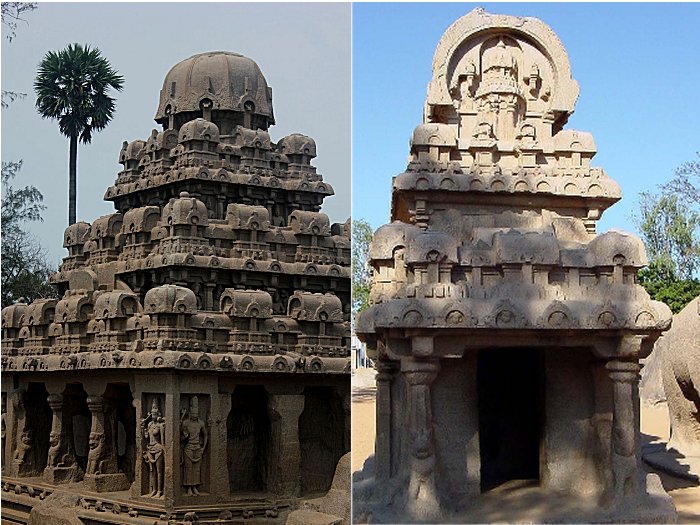 Left: Arjuna Ratha, Image credit: Xcibaangel- CC BY-SA 3.0; Right: Nakula Sahadeva Ratha. Image credit: G41rn8 - CC BY-SA 4.0
Left: Arjuna Ratha, Image credit: Xcibaangel- CC BY-SA 3.0; Right: Nakula Sahadeva Ratha. Image credit: G41rn8 - CC BY-SA 4.0
The city’s stone structures include mandapas (cave sanctuaries), which were typically built as a square vestibule, hall with pillars, or pavilion. Cells or sanctums would often be included, creating facilities for dwellings (vihara). The mandapas were used for people to gather socially, usually for ceremonies and rite-of-passage rituals.
There are many mandapas at Mahabalipuram, all dated to the 7th and 8th centuries. Other monuments are: the Rathas (‘chariots to the gods’) - striking rock-cut temples carved out of a single boulder, in the form of chariots, and dated to 600AD and 800 AD.
These rock-cut temples, named after the five Pandava brothers (Arjuna, Yudhistira, Bhima, Nakula, and Sahadeva) demigod warrior princes, and the heroes of the ancient Sanscrit epic poem Mahabharata are the outstanding examples of Pallava art.
Left: Dharmaraja‘s Ratha. Credit: Samrajclicks - CC BY-SA 4.0 - Right: Draupathi Ratha. Credit: Samrajclicks - CC BY-SA 4.0
Rathas – the full-sized models - recall the earlier architecture of the Buddhist chapels and monasteries. The architecture resembles Dravidian temples with their grand towers, sculptured walls, and halls decorated with Dravidian-style pillars.
Mahendravarman I (600-630 AD) was a great supporter of the arts. He had a passion for religion, so he introduced rock-cut architecture to the Pallava Dynasty.
He wanted both temples and artwork that decorated them to survive both weather and the passing of time. Therefore, he used a rock as a building material to better preserve the temples.
When he died, the temples were still not completed in the city of Mahabalipuram. His son was not so interested in art as his father, and he preferred to develop his military skills instead. The five temples have never been built, like his father, Mahendravarman, intended to do.
Bhima Ratha. Credit: Zuhebkhan94 - CC BY-SA 4.0
They stand unfinished until today and are called the Five Rathas of Mahabalipuram.
Another stone structure, the Shore Temple dedicated to the god Shiva is also one of Mahabalipuram’s most noted landmarks. Today, the facility is eroded and somewhat ruined, but it still holds many artistic details intact.
However, interestingly, this temple clearly shows a change in temple construction. The nearby five rathas are rock-hewn monoliths; the Shore Temple, on the other hand, is stone-built. It is considered one of the earliest stone-built temples in India.
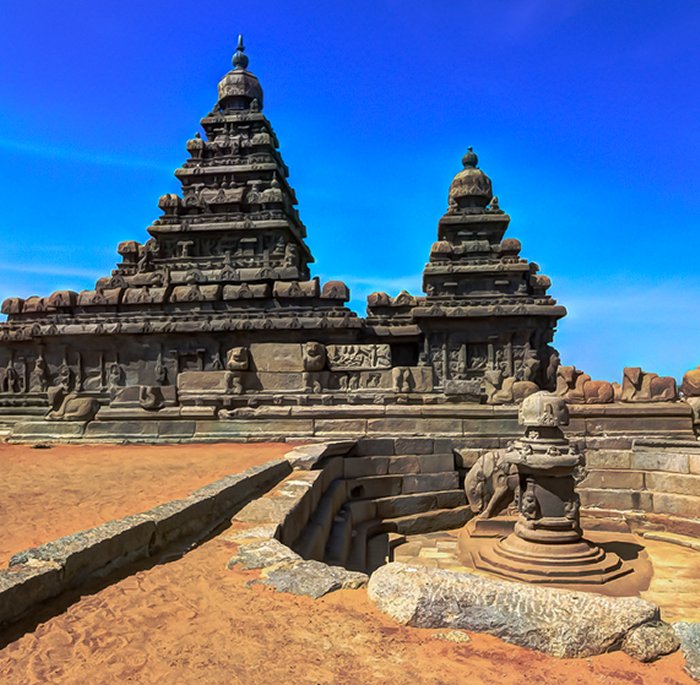 Shore temple, Mahabalipuram, India. Image credit: Balasubramanian S - CC BY-SA 3.0
Shore temple, Mahabalipuram, India. Image credit: Balasubramanian S - CC BY-SA 3.0
It has a 16 sided lingam and a relief of Somaskanda, a form of Shiva dated to the early Pallava period (275 AD to 897 AD) that became widely popular.
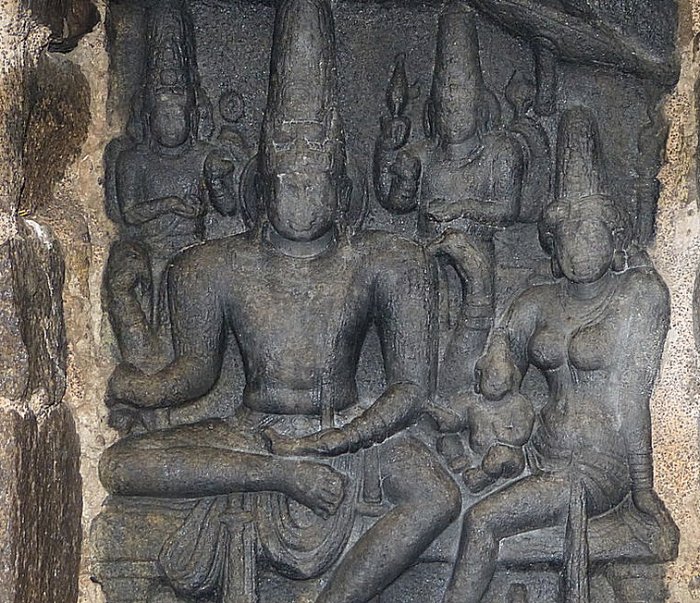 Somaskanda Panel with Shiva, Uma, and their son Skanda. Image credit: SatishKumar- CC BY-SA 3.0
Somaskanda Panel with Shiva, Uma, and their son Skanda. Image credit: SatishKumar- CC BY-SA 3.0
Yet another architectural attraction of Mahabalipuram is a spectacular and massive open-air bas-relief sculpted out of pink granite. The boulder is carved with 153 different deities, humans, and various animals carved on it.
This relief is like the Mahabharata epic poem with beautiful mythical scenes, battles, and figures of animals, beings, gods, and goddesses. It also depicts the story of Arjuna doing penance to attain a weapon from Lord Shiva to fight his enemies. It also shows the story of the Ganges descent from the Himalayas.
 Arjuna's Penance relief. Image credit: Sainath adapa _ CC BY-SA 3.0
Arjuna's Penance relief. Image credit: Sainath adapa _ CC BY-SA 3.0
The open-air bas-relief was carved on the face of two gigantic, connecting boulders, approximately 96 feet long (29 meters) and 43 feet (13 meters) high. The brilliant artwork dates back to the mid-seventh century.
The concept of the story includes an essential piece of Hindu philosophy. It says that a person could, by penance, the infliction of pain, or other discomforts on oneself, reach miraculous blessings from the Gods.
The ‘Descent of Ganges’ story, on the other hand, describes the penance of the Sage Bhagirathi, who performed austerities to bring Goddess Ganges down to earth.
Written by – A. Sutherland - AncientPages.com Senior Staff Writer
Copyright © AncientPages.com All rights reserved. This material may not be published, broadcast, rewritten or redistributed in whole or part without the express written permission of AncientPages.com
More From Ancient Pages
-
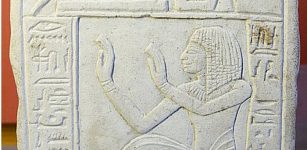 Meretseger: Theban Cobra Goddess Who Presided Over The Valley of The Kings
Egyptian Mythology | Jul 10, 2021
Meretseger: Theban Cobra Goddess Who Presided Over The Valley of The Kings
Egyptian Mythology | Jul 10, 2021 -
 Oldest Scandinavian Ship-Burial Identified Re-Writes History – Amazing Find That Predates The Viking Age
Archaeology | Nov 14, 2023
Oldest Scandinavian Ship-Burial Identified Re-Writes History – Amazing Find That Predates The Viking Age
Archaeology | Nov 14, 2023 -
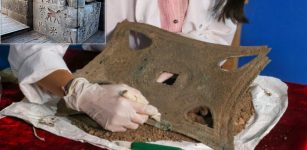 Ornamental Bronze Wall Plate Unearthed In Ayanis Castle Built By Urartian King Rusa II
Archaeology | Sep 13, 2022
Ornamental Bronze Wall Plate Unearthed In Ayanis Castle Built By Urartian King Rusa II
Archaeology | Sep 13, 2022 -
 Ethical Ancient DNA Research Must Involve Descendant Communities – Researchers Say
Archaeology | Jan 13, 2023
Ethical Ancient DNA Research Must Involve Descendant Communities – Researchers Say
Archaeology | Jan 13, 2023 -
 Very Rare Discovery: Viking Age Mortuary House Unearthed In Central Norway
Archaeology | Sep 29, 2019
Very Rare Discovery: Viking Age Mortuary House Unearthed In Central Norway
Archaeology | Sep 29, 2019 -
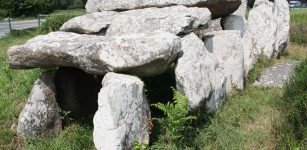 Mysterious Megalithic Stones Of Carnac, France – An Unsolved Neolithic Enigma
Civilizations | Oct 12, 2018
Mysterious Megalithic Stones Of Carnac, France – An Unsolved Neolithic Enigma
Civilizations | Oct 12, 2018 -
 Sacred ‘Sign Posts’ Of The Inuit People
Ancient History Facts | Sep 4, 2018
Sacred ‘Sign Posts’ Of The Inuit People
Ancient History Facts | Sep 4, 2018 -
 Remarkable Discovery Of Ancient Drilled Bear Teeth In Kansas – How Did They End Up On The Great Plains?
Archaeology | Mar 25, 2022
Remarkable Discovery Of Ancient Drilled Bear Teeth In Kansas – How Did They End Up On The Great Plains?
Archaeology | Mar 25, 2022 -
 Scientists Investigate – Did The Human Brain Shrink 3,000 Years Ago?
Human Beginnings | Aug 6, 2022
Scientists Investigate – Did The Human Brain Shrink 3,000 Years Ago?
Human Beginnings | Aug 6, 2022 -
 Jamukha: Mongolian Leader, Military And Childhood Friend Of Genghis Khan But Not Forever
Featured Stories | May 8, 2019
Jamukha: Mongolian Leader, Military And Childhood Friend Of Genghis Khan But Not Forever
Featured Stories | May 8, 2019 -
 Ancient People In Tasmania Witnessed Stunning Auroras When The Earth’s Magnetic Field Flipped
News | Feb 19, 2021
Ancient People In Tasmania Witnessed Stunning Auroras When The Earth’s Magnetic Field Flipped
News | Feb 19, 2021 -
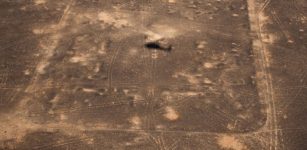 ‘Spectacular’ New Find: Roman Military Camps In Desert Found By Archaeologists Using Google Earth
Archaeology | Apr 27, 2023
‘Spectacular’ New Find: Roman Military Camps In Desert Found By Archaeologists Using Google Earth
Archaeology | Apr 27, 2023 -
 Mysterious Fontainebleau Forest – Home To A Lost Civilization
Civilizations | Jun 23, 2020
Mysterious Fontainebleau Forest – Home To A Lost Civilization
Civilizations | Jun 23, 2020 -
 Knowledge Of Divine Alien Beings And High-Tech In Ancient Egypt Described In Sacred Books And Papyrus – The God Who Spoke About Time Dilation – Part 1
Featured Stories | May 12, 2021
Knowledge Of Divine Alien Beings And High-Tech In Ancient Egypt Described In Sacred Books And Papyrus – The God Who Spoke About Time Dilation – Part 1
Featured Stories | May 12, 2021 -
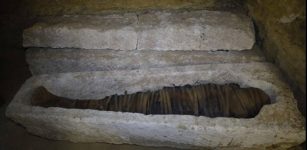 Tombs With Sarcophagi Of High Priests Including One Dedicated To Sky God Horus Unearthed In Egypt
Archaeology | Jan 31, 2020
Tombs With Sarcophagi Of High Priests Including One Dedicated To Sky God Horus Unearthed In Egypt
Archaeology | Jan 31, 2020 -
 Unknown 500,000-Year-Old Migration Route Of Homo Erectus From Africa – Discovered
Archaeology | May 10, 2019
Unknown 500,000-Year-Old Migration Route Of Homo Erectus From Africa – Discovered
Archaeology | May 10, 2019 -
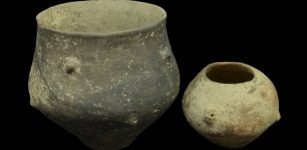 New Insight Into Genetic History And Social Structures In Neolithic And Bronze Age Croatia
Archaeology | Aug 18, 2021
New Insight Into Genetic History And Social Structures In Neolithic And Bronze Age Croatia
Archaeology | Aug 18, 2021 -
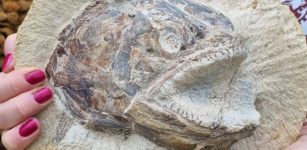 183-Million-Year-Old Fossils: Jurassic Marine World In A Farmer’s Field
Fossils | Jul 31, 2022
183-Million-Year-Old Fossils: Jurassic Marine World In A Farmer’s Field
Fossils | Jul 31, 2022 -
 Massive Eruption Of Iceland’s Laki Volcano Triggered An Unusually Cold Winter In 1783-84
Archaeology | May 21, 2019
Massive Eruption Of Iceland’s Laki Volcano Triggered An Unusually Cold Winter In 1783-84
Archaeology | May 21, 2019 -
 America’s First Civilization Was Made Up Of ‘Sophisticated’ Engineers – New Evidence
Archaeology | Sep 2, 2021
America’s First Civilization Was Made Up Of ‘Sophisticated’ Engineers – New Evidence
Archaeology | Sep 2, 2021


